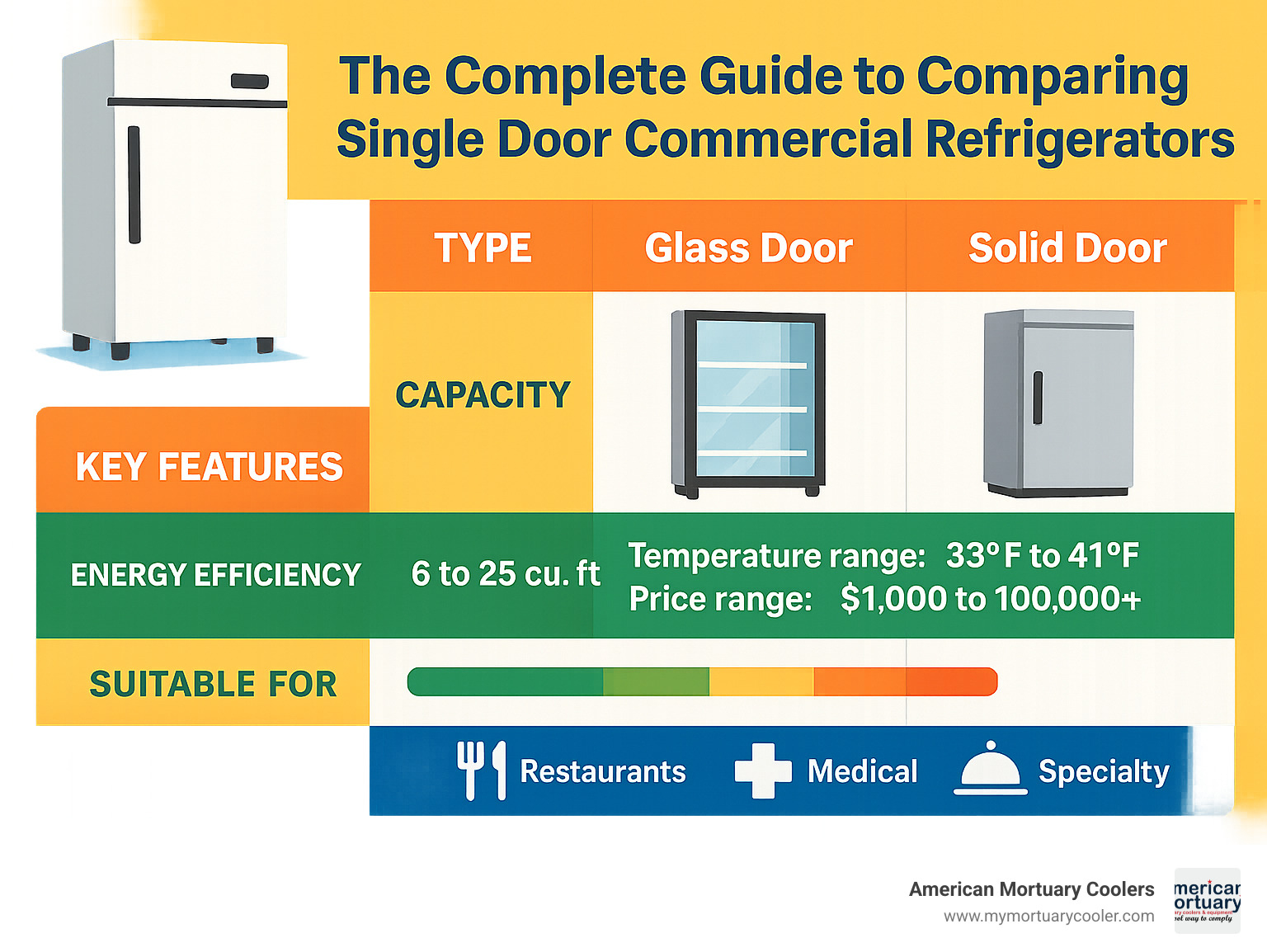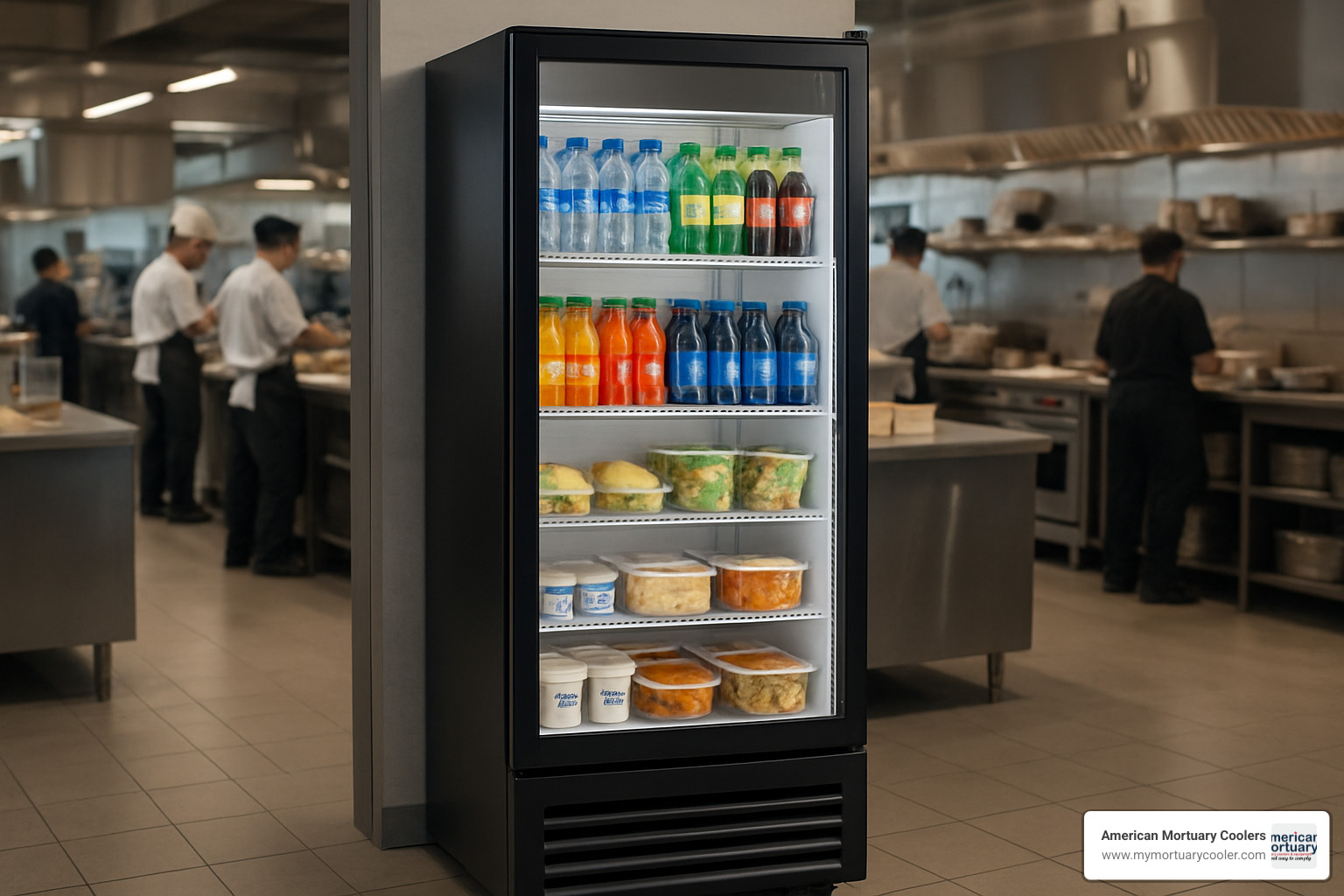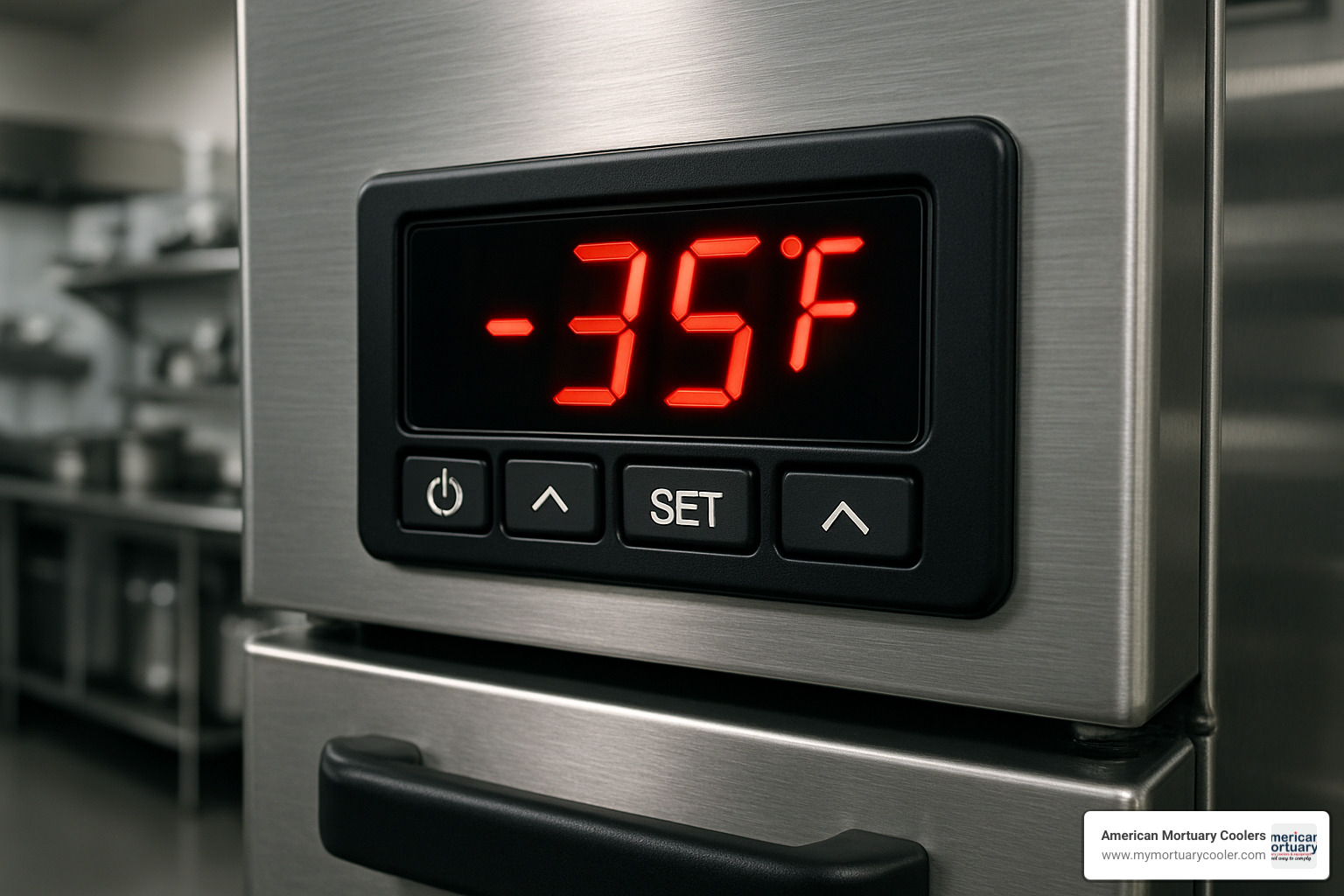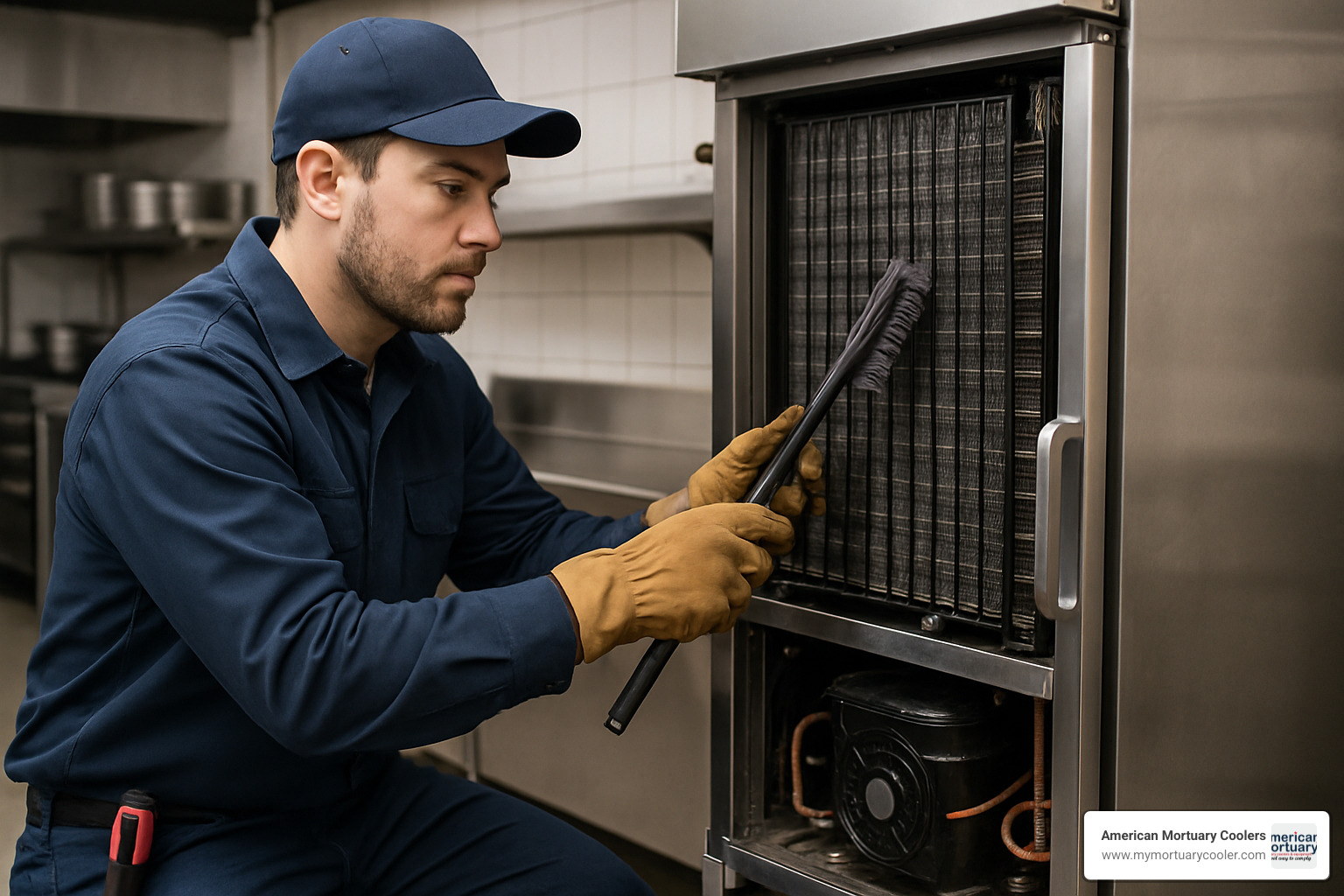Why Single Door Commercial Refrigerators Are Essential for Professional Operations
A single door commercial refrigerator is a heavy-duty, reach-in cooling unit designed for professional food service, medical, and specialty applications that require reliable temperature control and frequent access. Unlike residential models, these units feature robust compressors, NSF certification, and commercial-grade construction to handle continuous daily use.
Key specifications for single door commercial refrigerators:
- Capacity range: 6 to 25 cubic feet
- Standard widths: 25 to 30 inches
- Temperature range: 33°F to 41°F (1°C to 5°C)
- Price range: $1,000 to $10,000+
- Common types: Glass door merchandisers, solid door reach-ins, undercounter units
- Power requirements: 115V standard electrical connection
- Certifications: ETL electrical safety and sanitation approved
Whether you're operating a restaurant kitchen, medical facility, or funeral home, choosing the right single door unit means balancing storage capacity, energy efficiency, and specialized features like digital controls, automatic defrost, and security locks. Glass door models offer product visibility for merchandising, while solid door units provide better insulation and energy savings.
The most popular brands include Avantco, True, Maxx Cold, and Beverage-Air, with customer ratings typically ranging from 3.0 to 5.0 stars. Many modern units now use eco-friendly R-290 refrigerant and feature programmable digital controls for precise temperature management.
I'm Mortuary Cooler, a national-level mortuary cooler supplier with extensive experience helping funeral homes and medical facilities select the right single door commercial refrigerator for their specific needs. My background in commercial refrigeration has shown me that choosing the wrong unit can lead to costly repairs, food safety issues, and operational headaches that are easily preventable with proper guidance.

Single door commercial refrigerator terms made easy:
What Is a Single Door Commercial Refrigerator & Key Differences
When you walk into a busy restaurant kitchen or medical facility, you'll notice something different about their refrigerators right away. A single door commercial refrigerator isn't just a bigger version of what's in your home—it's built from the ground up for an entirely different world.
These units are the workhorses of professional environments where opening and closing the door dozens of times per day is normal, not exceptional. While your home fridge might get opened 10-15 times daily, commercial units routinely handle 50+ door openings without breaking a sweat.
The real difference starts with the heavy-duty compressor. Commercial refrigerators use compressors that are typically 1/3 to 1/2 horsepower—significantly more powerful than residential units. This extra power isn't just for show; it's essential for maintaining consistent temperatures when the door opens frequently or when large quantities of warm items are added.
NSF and ETL certifications are another crucial distinction. These aren't just fancy badges—they're your guarantee that the unit meets strict food safety and electrical safety standards. NSF certification specifically ensures the refrigerator can maintain proper temperatures for food safety compliance, which is legally required in most commercial food service operations.
How a single door commercial refrigerator differs from a household fridge
The construction quality difference becomes obvious the moment you touch these units. Commercial refrigerators use AISI 304 18/10 stainless steel throughout—both inside and out. This isn't just about looks (though they do look professional). Stainless steel resists bacteria buildup and makes thorough sanitization possible, something that's nearly impossible with the painted steel or plastic interiors found in home units.
Fan-forced airflow is where commercial units really shine. Instead of relying on natural air circulation like your home fridge, commercial units use powerful fans to move air throughout the cabinet. This means when you open that door for the twentieth time during lunch rush, the temperature bounces back quickly and stays consistent from top to bottom.
The duty cycle tells the real story though. Your home refrigerator is designed to run about 30-40% of the time—it cycles on and off throughout the day. Commercial units are built to run continuously if needed. They're marathon runners, not sprinters.
Advantages of a single door commercial refrigerator over multi-door models
Space is always at a premium in commercial kitchens, and single door units deliver maximum storage in minimal footprint. While a two-door unit typically measures 48-54 inches wide, a single door model fits into just 25-30 inches of precious floor space.
The cost savings are significant too. You can get into a quality single door commercial unit starting around $1,000, while comparable two-door models typically start at $2,000 or more. For smaller operations or specialized uses, that difference can make or break the budget.
Energy efficiency often favors single door units in real-world use. Here's why: when you open one door of a two-door unit, you're accessing only half the storage space but losing cold air from that entire section. With a single door unit, every opening gives you access to the complete storage area, making each door opening more productive and energy-efficient.
Types, Sizes & Capacities of Single Door Commercial Refrigerators

When you're shopping for a single door commercial refrigerator, the sheer number of options might make your head spin. But here's the good news—most buyers actually need one of just a few main types, and once you know your use case, the choice becomes much clearer.
Think of it this way: a busy restaurant kitchen has completely different needs than a medical office or a small convenience store. The 6 cubic foot countertop units work perfectly for that corner coffee shop, while the big 25 cubic foot reach-in models are what you'll find in professional kitchens that never sleep.
Most of our customers end up choosing something in the 12 to 20 cubic foot range. It's that sweet spot where you get plenty of storage without the energy bills that come with the monster units. Plus, these mid-size refrigerators fit through standard doorways—trust me, you don't want to find your new fridge won't fit through the door after it arrives.
The 25 to 30 inch width is pretty standard across the industry. Manufacturers designed these dimensions to work with existing commercial kitchen layouts, and heights usually hover around 72 to 84 inches. Most commercial spaces can handle an 82-inch tall unit without bumping into ceiling fixtures or ventilation systems.
Types of single door commercial refrigerators
Glass door merchandisers are the show-offs of the refrigerator world, and they're proud of it. These units want everyone to see what's inside—that's literally their job. The double-pane insulated glass keeps things cold while the LED lighting makes your beverages, sandwiches, or grab-and-go items look irresistible to customers.
Take the Maxx Cold 25" Glass Door Merchandiser, for example. It gives you 16 cubic feet of storage space and those illuminated top panels that make everything inside look like it belongs in a high-end display case. Perfect for convenience stores, cafes, or anywhere you want customers to see what you're selling.
Solid door reach-in refrigerators are the workhorses that keep commercial kitchens running. They don't need to look pretty—they just need to keep your ingredients at the right temperature, day after day, without complaining. The stainless steel doors provide better insulation than glass, which means lower energy costs over time.
The Avantco A-19R-HC is a perfect example of this type. It packs 17.3 cubic feet of storage into a 29-inch wide space, giving you serious storage capacity without taking over your entire kitchen. These units are built for the behind-the-scenes work of food service.
Undercounter units are the space-saving heroes of tight commercial spaces. When every square inch counts, these compact refrigerators slide right under your countertop while still delivering commercial-grade performance. Bars love them, small cafes depend on them, and medical facilities use them when they need reliable cooling in minimal space.
Medical and pharmaceutical refrigerators play by different rules entirely. These specialized units come with precise temperature controls, digital displays, and monitoring systems that can track and log temperatures over time. When you're storing vaccines, medications, or laboratory samples, "close enough" isn't good enough.
Typical dimensions & internal volume
Here's something that surprises a lot of first-time buyers: the outside dimensions and the inside storage space can be quite different. A typical 23 cubic foot single door commercial refrigerator measures about 29 inches wide, 31 inches deep, and 84 inches tall on the outside. But inside, you're looking at roughly 23 inches wide, 26 inches deep, and 56 inches of usable height.
Where did all that space go? Four-inch thick insulation ate it up, and you should be grateful for that. This heavy-duty insulation is what keeps your unit energy efficient and maintains steady temperatures even when your kitchen gets busy. It's also what helps these refrigerators exceed EISA energy standards, which saves you money on electricity bills.
Don't forget about ceiling clearance when you're planning your installation. Most units need 6 to 12 inches of breathing room above them for proper ventilation. So that 84-inch tall refrigerator actually needs a ceiling height of at least 90 to 96 inches. We've seen too many installations where someone forgot to measure ceiling height—it's not a fun surprise when the delivery truck shows up.
The relationship between external footprint and internal storage is something to consider carefully. You're not just buying floor space; you're buying usable storage space. A well-designed commercial unit maximizes that internal volume while still providing the insulation and durability you need for years of reliable service.
Key Features, Pricing Factors & How to Choose

When you're shopping for a single door commercial refrigerator, the sheer number of features can feel overwhelming. But here's the thing—most of these features actually make your life easier once you understand what they do.
Digital controllers have come a long way from the old dial thermostats. Modern units like the Avantco A Plus series let you set exact temperatures, program automatic defrost cycles, and even switch on eco-mode when things get quiet. These aren't just fancy bells and whistles—they're tools that help you save money and keep food safe.
The switch to R-290 refrigerant is happening across the industry, and for good reason. This new refrigerant has zero impact on the ozone layer and barely affects global warming compared to older options. Plus, it actually works more efficiently, which means lower electric bills for you.
LED lighting has practically taken over the commercial refrigeration world. These lights last longer, use less power, and don't heat up your refrigerator like the old fluorescent bulbs did. When you're checking inventory at the end of a long day, good lighting makes all the difference.
Quality shelving systems might not seem exciting, but adjustable wire shelves that can handle heavy loads save you countless headaches. Look for units with security locks—especially important in medical facilities or areas where you need to control access to expensive inventory.
Brand reputation matters more than you might think. Avantco, True, and Maxx Cold have earned their stripes by building units that keep running year after year. A good warranty backing up that reputation gives you real peace of mind.
Feature checklist for a single door commercial refrigerator
Your single door commercial refrigerator needs to maintain 32-41°F consistently—not just most of the time, but always. Digital displays that show actual temperature readings help you stay compliant with health department requirements and catch problems before they become disasters.
Automatic defrost saves you from the misery of manually defrosting units during your busiest times. Quality systems run these cycles overnight when you're closed, so you never have to think about it. Trust me, you'll appreciate this feature during your first busy holiday season.
Eco-mode might sound like marketing fluff, but it genuinely cuts energy costs. These smart systems learn your usage patterns and dial back power consumption during slow periods. The Avantco A Plus series does this particularly well, automatically sensing when doors haven't been opened and adjusting accordingly.
Field-reversible doors give you flexibility when space is tight. Being able to change door swing direction on-site means you don't have to work around a poor layout or pay for a custom order. This feature has saved countless installations where the original plan didn't quite work out.
Programmable alarms act like your refrigerator's smoke detector—you hope you never need them, but you're grateful they're there. Temperature alerts, power failure warnings, and door-ajar notifications can prevent thousands of dollars in lost inventory. For more detailed guidance on keeping your unit running smoothly, our commercial cooler repair guide covers the most common issues and solutions.
Glass vs. solid door models
The glass versus solid door decision usually comes down to whether you need to see what's inside or save on energy costs. Glass door models shine in retail settings where customers need to see products before buying. That double-pane insulated glass prevents condensation while the LED lighting makes everything look appealing.
But here's what the salespeople don't always mention—solid door units typically use 15-20% less energy. That thicker insulation really makes a difference on your electric bill, especially if you're running multiple units. The stainless steel construction also handles daily wear and tear better than glass, which matters in busy commercial kitchens.
Glass doors need cleaning constantly to look professional. Every fingerprint shows, and in high-humidity environments, you'll be wiping them down multiple times per day. Solid doors hide normal wear much better and need less frequent attention to maintain their appearance.
The durability factor becomes important in rough environments. We've seen glass doors crack from kitchen cart impacts or temperature shock, while solid doors just keep working. Consider your specific environment and how much abuse the door might take.
For deeper technical information about door systems and their impact on performance, Commercial Refrigeration Equipment: Door Systems provides comprehensive details about different door configurations and their applications.
Installation, Maintenance & Energy Efficiency

Getting your single door commercial refrigerator installed correctly is like building a house—get the foundation wrong, and everything else suffers. I've watched too many business owners skip the basics only to wonder why their unit keeps breaking down or their electric bills are through the roof.
Space planning starts with understanding clearance requirements. Your unit needs room to breathe—literally. Plan for 6 inches of clearance on all sides and 12 inches above for proper airflow. Those bottom-mounted compressor units? They need extra space below for service access too. Cramming a unit into a tight corner might save floor space, but it'll cost you big time in repairs and energy bills.
Temperature matters more than most people realize. Your refrigerator works hard in a busy kitchen, but when ambient temperatures climb above 90°F, even the best units start struggling. Installing near fryers or in poorly ventilated areas is asking for trouble. The unit will work overtime trying to stay cool, driving up energy costs and wearing out components faster.
Don't forget about electrical requirements. Most units need a dedicated 115V/15A circuit. Sounds simple, but older buildings often have electrical systems that can't handle the load properly. Sharing circuits with other equipment causes voltage drops that make compressors work harder and fail sooner.
Routine cleaning & preventive care
Daily care keeps your investment running smoothly. Wipe down surfaces with approved sanitizers—but remember that stainless steel needs specific cleaners to prevent corrosion. Those door gaskets deserve special attention since damaged seals cause most temperature problems we see in service calls.
Weekly deep cleaning means emptying the unit completely and giving everything a thorough scrub. Hot soapy water for shelves, followed by proper sanitization according to health department rules. This is also your chance to listen for unusual noises or check for temperature swings that might signal problems.
Here's the maintenance task that saves the most money: quarterly condenser coil cleaning. Dirty coils can spike your energy bill by 30% or more. Use a soft brush or compressed air to gently remove dust and debris, being careful not to damage the delicate fins. It's fifteen minutes of work that can save hundreds in energy costs.
Most manufacturers provide detailed maintenance guides. You can download the manual for step-by-step instructions specific to your model.
Common troubleshooting often comes down to three culprits: door seals that don't close properly, iced-up coils from poor airflow, or thermostat issues. Many problems that seem major actually have simple solutions when you know what to look for.
Cost of ownership & warranty
Upfront costs range from $1,000 for basic models to over $10,000 for premium units with all the bells and whistles. But here's what many buyers miss—the sticker price is just the beginning. Energy costs, maintenance, and potential product losses from equipment failure add up over time.
Energy efficiency pays for itself faster than you might think. Units with eco-mode and ENERGY STAR ratings can cut operating costs by 20-30% compared to basic models. Over ten years, those savings often exceed the initial price difference. Modern R-290 refrigerant also helps reduce environmental impact while maintaining excellent cooling performance.
Warranty protection typically covers 1-2 years for parts and labor, with 5-6 years on the compressor. Quality brands like True and Avantco back their products with solid warranties, but terms vary significantly. Read the fine print carefully—some warranties become void if you don't follow maintenance schedules or use unauthorized repair services.
Smart buyers factor in the total cost of ownership, not just the purchase price. Our Ultimate Guide to Finding an Affordable Cooler shows you how to balance upfront costs with long-term value, helping you make the right choice for your specific situation and budget.
Frequently Asked Questions about Single Door Commercial Refrigerators
After helping hundreds of funeral homes and commercial operations choose the right refrigeration equipment, I've noticed the same questions come up repeatedly. Let me share the answers that matter most when you're investing in a single door commercial refrigerator.
How much space do I need behind and above the unit?
Here's where many people get tripped up during installation. Your single door commercial refrigerator needs 6 inches of clearance on all sides and 12 inches above the unit. This isn't just a suggestion from the manufacturer—it's absolutely critical for proper operation.
If you're looking at a bottom-mounted compressor unit, add another 4-6 inches below for service access. I've seen too many units fail prematurely because someone thought they could squeeze them into tight spaces. The compressor overheats, energy bills skyrocket, and you're looking at expensive repairs.
Don't forget about door swing clearance either. Measure the full arc of the door opening to make sure it won't hit walls, other equipment, or create workflow problems. A refrigerator that's difficult to access becomes a daily frustration for your staff.
What temperature range should I set for dairy or raw meat?
Food safety isn't negotiable, especially in commercial settings. Dairy products need to stay at 38°F or below, while raw meat requires the colder range of 32-36°F. Most quality commercial units handle these temperatures easily, but proper loading makes all the difference.
The biggest mistake I see is overloading units. When you pack items too tightly, air can't circulate properly, creating warm spots that compromise food safety. Leave space between items and avoid blocking the internal fans.
Here's a pro tip: place a separate thermometer near the door—that's usually the warmest spot in the unit. Don't rely solely on the digital display, which typically shows the temperature at the sensor location, not necessarily the warmest area.
How often should I defrost or clean condenser coils?
Good news about defrosting—modern single door commercial refrigerators with automatic defrost systems handle this for you. These units typically run defrost cycles every 6-12 hours during quieter periods, usually overnight. Manual defrosting is rarely needed unless something goes wrong with the automatic system.
Condenser coil cleaning is a different story and absolutely critical for longevity. In busy kitchens with grease and dust, you might need monthly cleaning. Cleaner environments can stretch this to quarterly, but here's my simple rule: if you can see dust or debris on the coils, it's time to clean them.
Dirty coils can increase your energy bills by 30% or more. Use a soft brush or compressed air, working carefully to avoid damaging the delicate fins. It's one of those maintenance tasks that seems minor until you skip it and face a major repair bill.
The frequency really depends on your environment. Funeral homes typically have cleaner conditions than restaurant kitchens, so you might get away with less frequent cleaning. But don't gamble with it—set a regular schedule and stick to it.
Conclusion
Finding the right single door commercial refrigerator doesn't have to feel overwhelming. You've learned about the key differences between glass and solid doors, the importance of proper sizing, and why commercial units outperform household fridges in professional settings. Now it's time to put that knowledge to work.
The sweet spot for most businesses falls between 12-20 cubic feet of capacity, with NSF/ETL certification being non-negotiable for food safety compliance. Glass door merchandisers work beautifully when you need product visibility, while solid door reach-ins deliver better energy efficiency for back-of-house storage.
Remember the three pillars of success: proper installation with adequate clearances, regular maintenance including quarterly coil cleaning, and realistic budgeting that accounts for both purchase price and ongoing operating costs. A $3,000 unit that runs efficiently for ten years costs far less than a $1,500 unit that breaks down repeatedly.
At American Mortuary Coolers, we've been helping businesses across Tennessee and beyond find the perfect refrigeration solutions for their unique needs. Whether you're running a busy restaurant kitchen or managing a medical facility, we understand that reliable temperature control isn't just about convenience—it's about protecting your reputation and your bottom line.
Your single door commercial refrigerator should work as hard as you do. Don't settle for equipment that can't keep up with your demands. The right unit will quietly maintain perfect temperatures day after day, letting you focus on what really matters—serving your customers.
For specialized applications that go beyond standard commercial refrigeration, take a look at our Complete Guide to American Cooler Options. We craft custom solutions that fit your exact requirements, with direct delivery across all 48 contiguous states.
Ready to upgrade your refrigeration? Your business deserves equipment that delivers consistent performance, energy efficiency, and the peace of mind that comes with knowing your products are stored safely. Make the investment—your future self will thank you.
















